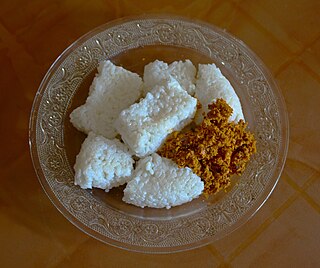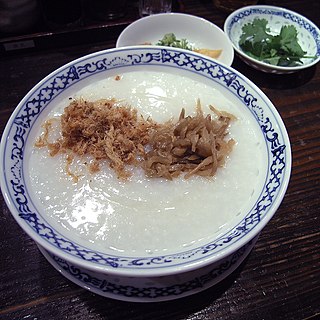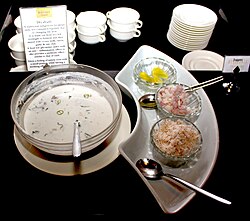
Palm wine, known by several local names, is an alcoholic beverage created from the sap of various species of palm trees such as the palmyra, date palms, and coconut palms. It is known by various names in different regions and is common in various parts of Africa, the Caribbean, South America, South Asia, Southeast Asia, and Micronesia.

A dosa is a thin, savoury crepe in South Indian cuisine made from a fermented batter of ground white gram and rice. Dosas are served hot, often with chutney and sambar. Dosas are popular in South Asia as well as around the world.

Indonesian cuisine is a collection of various regional culinary traditions that formed in the archipelagic nation of Indonesia. There are a wide variety of recipes and cuisines in part because Indonesia is composed of approximately 6,000 populated islands of the total 17,508 in the world's largest archipelago, with more than 1,300 ethnic groups.

Jaggery is a traditional non-centrifugal cane sugar consumed in the Indian subcontinent, Southeast Asia, Central America, Brazil and Africa. It is a concentrated product of cane juice and often date or palm sap without separation of the molasses and crystals, and can vary from golden brown to dark brown in colour. It contains up to 50% sucrose, up to 20% invert sugars, and up to 20% moisture, with the remainder made up of other insoluble matter, such as wood ash, proteins, and bagasse fibres. Jaggery is very similar to muscovado, an important sweetener in Portuguese, British and French cuisine. The Kenyan Sukari ngutu/nguru has no fibre; it is dark and is made from sugarcane and also sometimes extracted from palm tree.

Malay cuisine is the traditional food of the ethnic Malays of Southeast Asia, residing in modern-day Malaysia, Indonesia, Singapore, Brunei, Southern Thailand and the Philippines as well as Cocos Islands, Christmas Island, Sri Lanka and South Africa.

Rice and curry is a popular dish in Sri Lanka, as well as in other parts of the Indian subcontinent.

Sri Lankan cuisine is known for its particular combinations of herbs, spices, fish, vegetables, rices, and fruits. The cuisine is highly centered around many varieties of rice, as well as coconut which is a ubiquitous plant throughout the country. Seafood also plays a significant role in the cuisine, be it fresh fish or preserved fish. As a country that was a hub in the historic oceanic silk road, contact with foreign traders brought new food items and cultural influences in addition to the local traditions of the country's ethnic groups, all of which have helped shape Sri Lankan cuisine. Influences from Indian, Indonesian and Dutch cuisines are most evident with Sri Lankan cuisine sharing close ties to other neighbouring South and Southeast Asian cuisines.

Arrack is a distilled alcoholic drink typically produced in India, Sri Lanka and Southeast Asia, made from the fermented sap of coconut flowers or sugarcane, and also with grain or fruit depending upon the country of origin. It is sometimes spelled arak, or simply referred to as 'rack or 'rak. It is not to be confused with the anise-flavored distilled spirit called arak or araq. In many parts of India arrack is colloquially known as "desi daru".

Tamil cuisine is a culinary style of Tamil people originating in the southern Indian state of Tamil Nadu and neighboring Sri Lanka. Meats, along with rice, legumes, and lentils, are popular. Dairy products and tamarind are used to provide sour flavors. On special occasions, traditional Tamil dishes are served in a traditional manner, using banana leaves in place of utensils. After eating, the banana leaves are then used as a secondary food for cattle. A typical breakfast meal consists of idli or dosa with chutney. Lunch includes rice, sambar, curd, kuzhambu, and rasam.

A falooda is a Mughalai cold dessert made with vermicelli. It has origins in the Persian dish faloodeh, variants of which are found across West, Central, South and Southeast Asia. Traditionally it is made by mixing rose syrup, vermicelli, and sweet basil seeds with milk, often served with ice cream. The vermicelli used for preparing falooda is made from wheat, arrowroot, cornstarch, or sago.

An appa or appam is a type of thin pancake originating from South India and Sri Lanka. It is made with fermented rice batter and coconut milk, traditionally cooked in an appachatti, a deep pan similar in shape to a wok. It is part of Tamil cuisine and Kerala cuisine found in the Indian states of Tamil Nadu and Kerala, and in Sri Lanka. Appam is most frequently served for breakfast or dinner, often with a topping such as an egg.

Dried shrimp are shrimp that have been sun-dried and shrunk to a thumbnail size. They are used in many East Asian, Southeast Asian and South Asian cuisines, imparting a unique umami taste. A handful of shrimp is generally used for dishes. The flavors of this ingredient are released when allowed to simmer.

Kiribath is a traditional Sri Lankan dish made from rice. It is prepared by cooking rice with coconut milk, hence this name, and can be considered a form of rice cake or rice pudding. Kiribath is an essential dish in Sri Lankan cuisine. It is very commonly served for breakfast on the first day of each month and also has the added significance of being eaten for any auspicious moment throughout one's lifetime which are marking times of transition. It is one of the more renowned traditional dishes in Sri Lanka.

Kokis is a deep-fried, crispy Sri Lankan food made from rice flour and coconut milk. Although considered as a traditional Sri Lankan dish, it is believed to have come from the Dutch. This is an important dish when celebrating Sinhala New Year and plays a major role in the festivities.

A great variety of cassava-based dishes are consumed in the regions where cassava is cultivated, and the ingredient is included many national or ethnic specialities.

Kalu dodol is a sweet dish, a type of dodol that is popular in Sri Lanka. The dark and sticky dish consists mainly of kithul jaggery, rice flour and coconut milk. Kalu dodol is a very difficult and time-consuming dish to prepare. The Hambanthota area is famous for the production of this dish.

Street food, as in other areas of India, are popular in Chennai, despite the common belief in India that street food is unhealthy. The idly sambhar is a popular dish, which is served as breakfast or dinner. Apart from regular South Indian street food, the city's streets are also filled with several North Indian street food outlets, most of them established by North Indian migrants themselves. Gujarati and Burmese are also available. Street food in Chennai is so popular that a game had developed based on the TV show The Amazing Race where contestants have to follow clues to street-food spots in the city.

Congee is a form of savoury rice porridge made by boiling rice in a large amount of water until the rice softens. Depending on rice-water ratio, the thickness of congee varies from a Western oatmeal porridge to a gruel. Since the history of rice cultivation in Asia stretches back to the Baiyue-inhabited lower Yangtze circa 10000 BC, congee is unlikely to have appeared before that date. Congee is typically served with side dishes, or it can be topped with meat, fish and pickled vegetables.


















